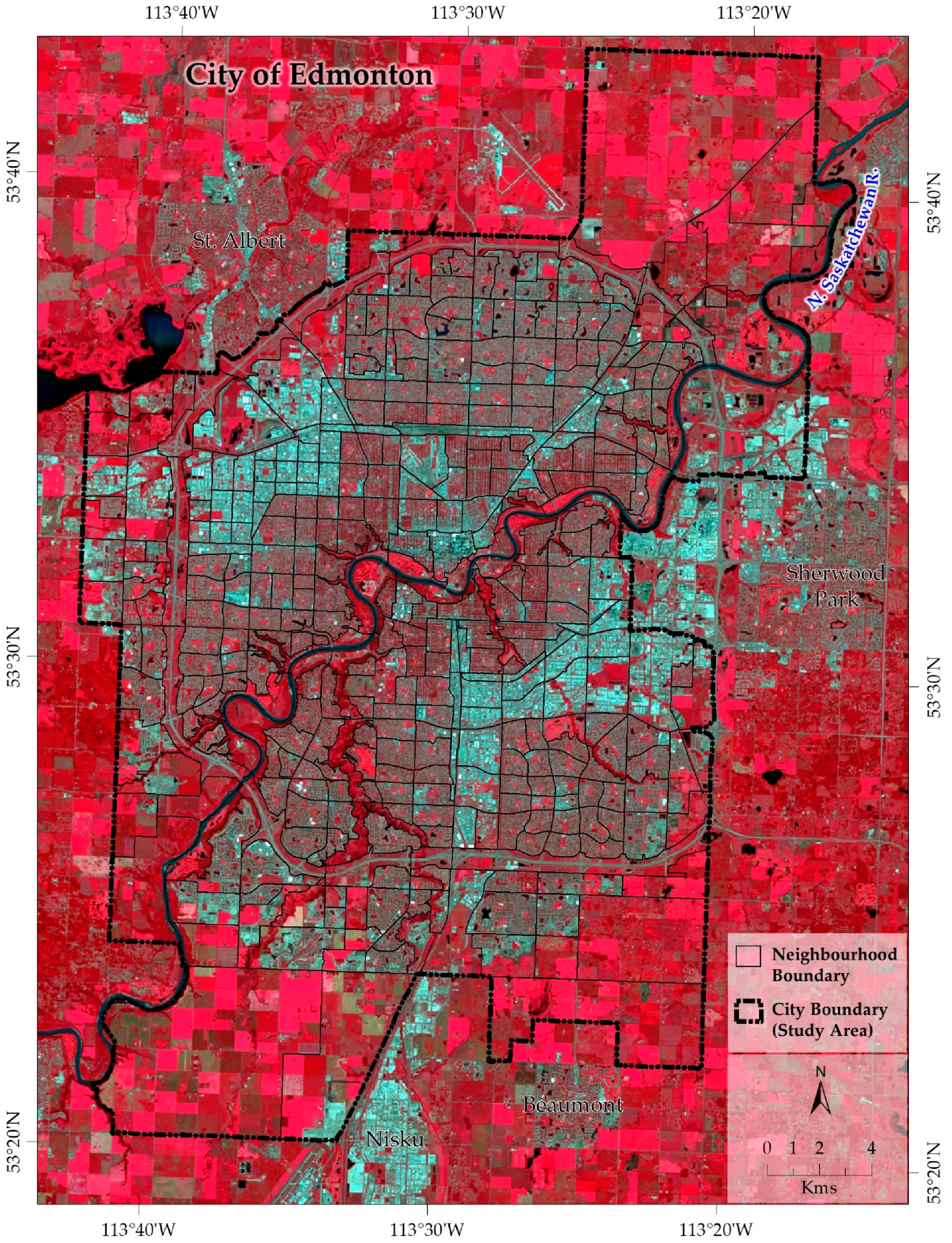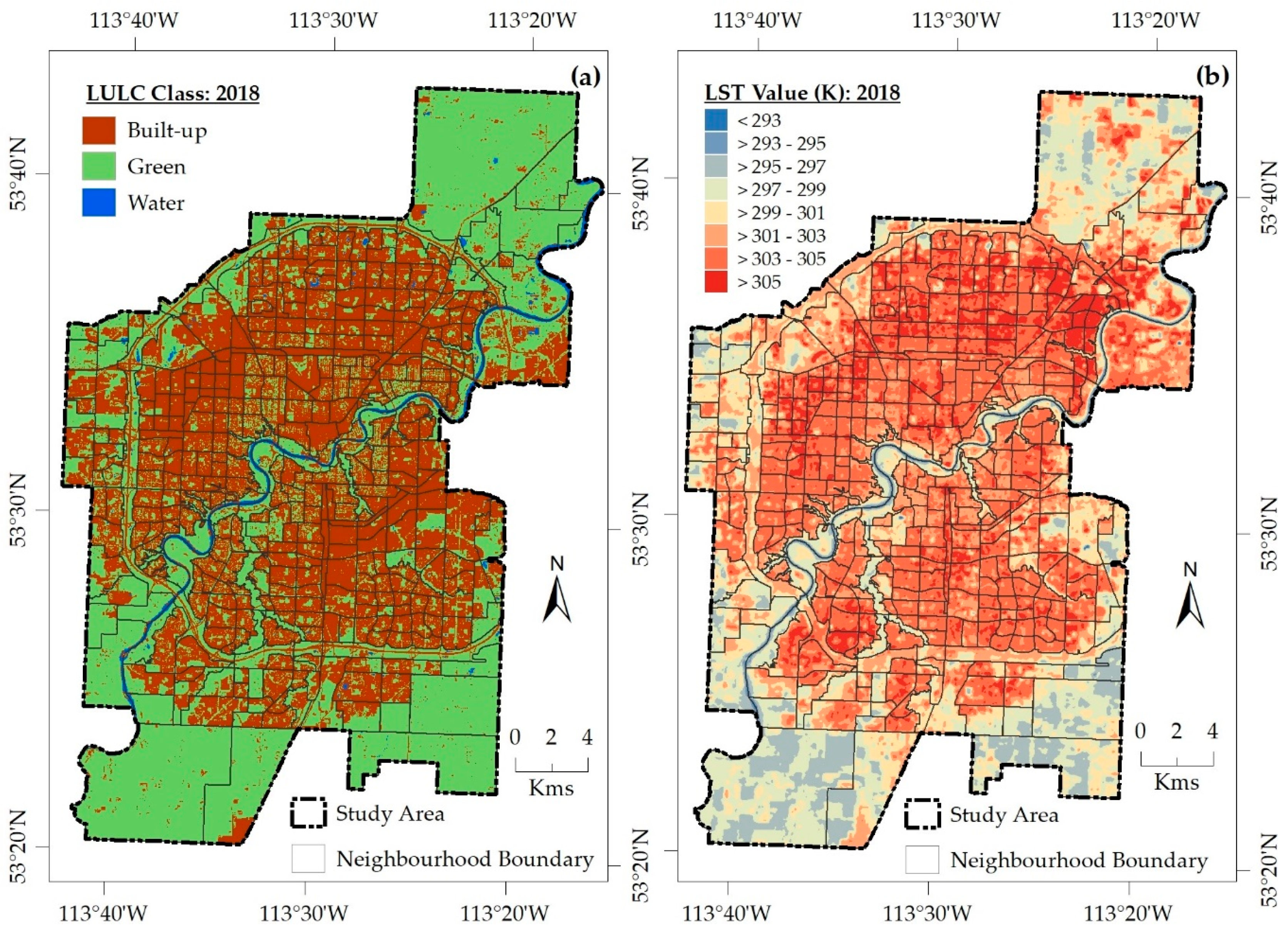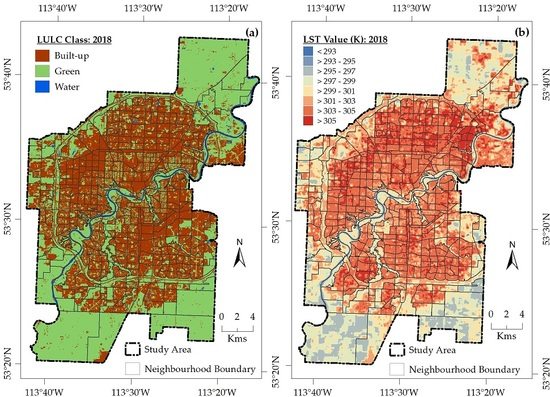Use of Remote Sensing in Comprehending the Influence of Urban Landscape’s Composition and Configuration on Land Surface Temperature at Neighbourhood Scale
Abstract
:1. Introduction
2. Study Area and Data Requirements
2.1. General Description of the Study Area
2.2. Data Requirements and Processing
3. Methods
3.1. Generation of LULC Classifications and Accuracy Assessments
3.2. Derivation of LST and Its Relations with LULC Composition
3.3. Analysis of the Influence of Structural Configurations on the LST at Neighbourhood Scale
4. Results
4.1. Evaluation of the LULC Maps and Dynamics of LST
4.2. Relationships between LST and LULC Composition
4.3. Influence of Structural Configurations on LST
5. Discussion
6. Conclusions
Author Contributions
Funding
Acknowledgments
Conflicts of Interest
References
- United Nations Secretariat World Urbanization Prospects. The 2001 Revision. Data Tables and Highlights. Available online: http://www.megacities.uni-koeln.de/documentation/megacity/statistic/wup2001dh.pdf (accessed on 29 June 2020).
- United Nations. World Urbanization Prospects: The 2018 Revision. Available online: https://population.un.org/wup/Publications/Files/WUP2018-Report.pdf (accessed on 29 June 2020).
- Wu, Z.; Zhang, Y. Spatial Variation of Urban Thermal Environment and Its Relation to Green Space Patterns: Implication to Sustainable Landscape Planning. Sustainability 2018, 10, 2249. [Google Scholar] [CrossRef] [Green Version]
- Mukherjee, S.; Joshi, P.K.; Garg, R.D. Analysis of urban built-up areas and surface urban heat island using downscaled MODIS derived land surface temperature data. Geocarto Int. 2017, 32, 900–918. [Google Scholar] [CrossRef]
- Shahmohamadi, P.; Che-Ani, A.I.; Maulud, K.N.A.; Tawil, N.M.; Abdullah, N.A.G. The Impact of Anthropogenic Heat on Formation of Urban Heat Island and Energy Consumption Balance. Urban Stud. Res. 2011, 2011. [Google Scholar] [CrossRef] [Green Version]
- Osborne, B.P.; Osborne, V.J.; Kruger, M.L. Comparison of satellite surveying to traditional surveying methods for the resources industry. JBIS—J. Br. Interplanet. Soc. 2012, 65, 98–104. [Google Scholar]
- Connors, J.P.; Galletti, C.S.; Chow, W.T.L. Landscape configuration and urban heat island effects: Assessing the relationship between landscape characteristics and land surface temperature in Phoenix, Arizona. Landsc. Ecol. 2013, 28, 271–283. [Google Scholar] [CrossRef]
- Afrin, S.; Gupta, A.; Farjad, B.; Razu Ahmed, M.; Achari, G.; Hassan, Q. Development of land-use/land-cover maps using landsat-8 and MODIS data, and their integration for hydro-ecological applications. Sensors 2019, 19, 4891. [Google Scholar] [CrossRef] [Green Version]
- Akbar, T.A.; Hassan, Q.K.; Ishaq, S.; Batool, M.; Butt, H.J.; Jabbar, H. Investigative Spatial Distribution and Modelling of Existing and Future Urban Land Changes and Its Impact on Urbanization and Economy. Remote Sens. 2019, 11, 105. [Google Scholar] [CrossRef] [Green Version]
- Ullah, S.; Tahir, A.A.; Akbar, T.A.; Hassan, Q.K.; Dewan, A.; Khan, A.J.; Khan, M. Remote Sensing—Based Quantification of the Relationships between Land Use Land Cover Changes and Surface Temperature over the Lower Himalayan Region. Sustainability 2019, 11, 5492. [Google Scholar] [CrossRef] [Green Version]
- Abdullah, A.Y.M.; Masrur, A.; Gani Adnan, M.S.; Al Baky, M.A.; Hassan, Q.K.; Dewan, A. Spatio-temporal patterns of land use/land cover change in the heterogeneous coastal region of Bangladesh between 1990 and 2017. Remote Sens. 2019, 11, 790. [Google Scholar] [CrossRef] [Green Version]
- Zhao, Z.Q.; He, B.J.; Li, L.G.; Wang, H.B.; Darko, A. Profile and concentric zonal analysis of relationships between land use/land cover and land surface temperature: Case study of Shenyang, China. Energy Build. 2017, 155, 282–295. [Google Scholar] [CrossRef]
- Hua, A.K.; Ping, O.W. The influence of land-use/land-cover changes on land surface temperature: A case study of Kuala Lumpur metropolitan city. Eur. J. Remote Sens. 2018, 51, 1049–1069. [Google Scholar] [CrossRef] [Green Version]
- Myint, S.W.; Zheng, B.; Talen, E.; Fan, C.; Kaplan, S.; Middel, A.; Smith, M.; Huang, H.; Brazel, A. Does the spatial arrangement of urban landscape matter? Examples of urban warming and cooling in phoenix and las vegas. Ecosyst. Heal. Sustain. 2015, 1, 1–15. [Google Scholar] [CrossRef]
- Zheng, B.; Myint, S.W.; Fan, C. Spatial configuration of anthropogenic land cover impacts on urban warming. Landsc. Urban Plan. 2014, 130, 104–111. [Google Scholar] [CrossRef]
- Rhee, J.; Park, S.; Lu, Z. Relationship between land cover patterns and surface temperature in urban areas. GIScience Remote Sens. 2014, 51, 521–536. [Google Scholar] [CrossRef]
- Li, J.; Song, C.; Cao, L.; Zhu, F.; Meng, X.; Wu, J. Impacts of landscape structure on surface urban heat islands: A case study of Shanghai, China. Remote Sens. Environ. 2011, 115, 3249–3263. [Google Scholar] [CrossRef]
- Weng, Q.; Liu, H.; Lu, D. Assessing the effects of land use and land cover patterns on thermal conditions using landscape metrics in city of Indianapolis, United States. Urban Ecosyst. 2007, 10, 203–219. [Google Scholar] [CrossRef]
- Fan, C.; Wang, Z. Spatiotemporal characterization of land cover impacts on urban warming: A spatial autocorrelation approach. Remote Sens. 2020, 12, 1631. [Google Scholar] [CrossRef]
- Wu, X.; Li, B.; Li, M.; Guo, M.; Zang, S.; Zhang, S. Examining the Relationship Between Spatial Configurations of Urban Impervious Surfaces and Land Surface Temperature. Chinese Geogr. Sci. 2019, 29, 568–578. [Google Scholar] [CrossRef] [Green Version]
- The City of Red Deer. Neighbourhood Planning & Design Standards. Available online: https://www.reddeer.ca/media/reddeerca/business-in-red-deer/planning-and-development-of-property/planning/Neighbourhood-Planning--Design-Standards-combined-June-2015.pdf (accessed on 29 June 2020).
- The City of Edmonton. Designing New Neighbourhoods. Guidelines for Edmonton’s Future Residential Communities. Available online: https://www.edmonton.ca/documents/PDF/Designing_New_Neighbourhoods_Final.pdf (accessed on 29 June 2020).
- The City of Edmonton. Facts & Figures. Available online: https://www.edmonton.ca/city_government/facts-figures.aspx (accessed on 18 May 2020).
- Government of Canada. 1981–2010 Climate Normals & Averages. Available online: https://climate.weather.gc.ca/climate_normals/ (accessed on 18 May 2020).
- USGS. EarthExplorer—Home. Available online: http://earthexplorer.usgs.gov/ (accessed on 20 May 2020).
- The City of Edmonton. City of Edmonton’s Open Data Portal. Available online: https://data.edmonton.ca/ (accessed on 19 May 2020).
- Ahmed, M.R.; Rahaman, K.R.; Kok, A.; Hassan, Q.K. Remote sensing-based quantification of the impact of flash flooding on the rice production: A case study over Northeastern Bangladesh. Sensors 2017, 17, 2347. [Google Scholar] [CrossRef] [Green Version]
- Mosleh, M.K.; Hassan, Q.K. Development of a remote sensing-based “boro” rice mapping system. Remote Sens. 2014, 6, 1938–1953. [Google Scholar] [CrossRef] [Green Version]
- Rouse, J.W.; Haas, R.H.; Schell, J.A.; Deering, D.W. Monitoring vegetation systems in the Great Plains with ERTS. In Third Earth Resources Technology Satellite-1 Symposium; NASA Special Publication 351: Washington, DC, USA, 1973; pp. 309–317. [Google Scholar]
- Xu, H. Modification of normalised difference water index (NDWI) to enhance open water features in remotely sensed imagery. Int. J. Remote Sens. 2006, 27, 3025–3033. [Google Scholar] [CrossRef]
- Zha, Y.; Gao, J.; Ni, S. Use of normalized difference built-up index in automatically mapping urban areas from TM imagery. Int. J. Remote Sens. 2003, 24, 583–594. [Google Scholar] [CrossRef]
- Avdan, U.; Jovanovska, G. Algorithm for Automated Mapping of Land Surface Temperature Using LANDSAT 8 Satellite Data. J. Sens. 2016, 2016. [Google Scholar] [CrossRef] [Green Version]
- Sobrino, J.A.; Jiménez-Muñoz, J.C.; Paolini, L. Land surface temperature retrieval from LANDSAT TM 5. Remote Sens. Environ. 2004, 90, 434–440. [Google Scholar] [CrossRef]
- Baldinelli, G.; Bonafoni, S.; Rotili, A. Albedo Retrieval from Multispectral Landsat 8 Observation in Urban Environment: Algorithm Validation by in situ Measurements. IEEE J. Sel. Top. Appl. Earth Obs. Remote Sens. 2017, 10, 4504–4511. [Google Scholar] [CrossRef]
- The City of Edmonton. Edmonton Zoning Bylaw 12800; City of Edmonton: Edmonton, AB, Canada, 2017. [Google Scholar]
- Anselin, L. Local Indicators of Spatial Association—LISA. Geogr. Anal. 1995, 27, 93–115. [Google Scholar] [CrossRef]
- Apparicio, P.; Pham, T.T.H.; Séguin, A.M.; Dubé, J. Spatial distribution of vegetation in and around city blocks on the Island of Montreal: A double environmental inequity? Appl. Geogr. 2016, 76, 128–136. [Google Scholar] [CrossRef] [Green Version]
- Mittal, J.; Byahut, S. Value Capitalization Effects of Golf Courses, Waterfronts, Parks, Open Spaces, and Green Landscapes—A Cross-Disciplinary Review. J. Sustain. Real Estate 2016, 8, 62–94. [Google Scholar]
- The City of Edmonton. Mature Neighbourhoods. Edmonton—Open Data Portal. Available online: https://data.edmonton.ca/Geospatial-Boundaries/Mature-Neighbourhoods-Map/3jmw-i9z8 (accessed on 29 June 2020).
- The City of Edmonton. Vacant Industrial Land Supply: Urban Form and Corporate Strategic Development City Planning; City of Edmonton: Edmonton, AB, Canada, 2018. [Google Scholar]
- Stiles, R.; Gasienica-wawrytko, B.; Hagen, K.; Loibl, W.; Tötzer, T.; Köstl, M.; Pauleit, S.; Schirmann, A.; Felmayr, W.; Trimmel, H. Understanding the whole city as landscape. A multivariate approach to urban landscape morphology. SPOOL 2014, 1, 401–418. [Google Scholar]
- Mustafa, A.; Heppenstall, A.; Omrani, H.; Saadi, I.; Cools, M.; Teller, J. Modelling built-up expansion and densification with multinomial logistic regression, cellular automata and genetic algorithm. Comput. Environ. Urban Syst. 2018, 67, 147–156. [Google Scholar] [CrossRef] [Green Version]
- Zhen, F.; Qin, X.; Ye, X.; Sun, H.; Luosang, Z. Analyzing urban development patterns based on the flow analysis method. Cities 2019, 86, 178–197. [Google Scholar] [CrossRef]
- Zhou, W.; Huang, G.; Cadenasso, M.L. Does spatial configuration matter? Understanding the effects of land cover pattern on land surface temperature in urban landscapes. Landsc. Urban Plan. 2011, 102, 54–63. [Google Scholar] [CrossRef]
- Kim, J.; Gu, D.; Sohn, W.; Kil, S.; Kim, H.; Lee, D. Neighborhood Landscape Spatial Patterns and Land Surface Temperature: An Empirical Study on Single-Family Residential Areas in Austin, Texas. Int. J. Environ. Res. Public Health 2016, 13, 880. [Google Scholar] [CrossRef] [PubMed] [Green Version]
- Fikfak, A.; Kosanovi, S.; Konjar, M.; Grom, J.; Zbašnik-senegă, M. The Impact of Morphological Features on Summer Temperature Variations on the Example of Two Residential Neighborhoods in Ljubljana, Slovenia. Sustainability 2017, 9, 122. [Google Scholar] [CrossRef] [Green Version]
- Vox, G.; Maneta, A.; Schettini, E. Evaluation of the radiometric properties of roofing materials for livestock buildings and their effect on the surface temperature. Biosyst. Eng. 2016, 144, 26–37. [Google Scholar] [CrossRef]
- Rossi, S.; Calovi, M.; Dalpiaz, D.; Fedel, M. The Influence of NIR Pigments on Coil Coatings’ Thermal Behaviors. Coatings 2020, 10, 514. [Google Scholar] [CrossRef]
- CLM Steel Roofing Edmonton. Benefits of Metal Roofing Over a Shingle Roof. Available online: https://clmmetalroofsalberta.ca/benefits-of-metal-roofing-over-a-shingle-roof/ (accessed on 29 June 2020).
- A. Clark Roofing & Siding LP. Factors to Consider When Choosing a Shingle Colour. Available online: https://www.aclark.ca/blog/factors-consider-choosing-shingle-colour/ (accessed on 18 June 2020).
- Akbari, H.; Kolokotsa, D. Three decades of urban heat islands and mitigation technologies research. Energy Build. 2016, 133, 834–842. [Google Scholar] [CrossRef]






| Category | Ref. | Description * |
|---|---|---|
| Fragmentation metrics | Li et al. [17] |
|
| Connors et al. [7] |
| |
| Wu and Zhang [3] |
| |
| Spatial autocorrelation | Zheng et al. [15] |
|
| Myint et al. [14] |
| |
| Wu et al. [20] |
|
| Landsat-8 Sensor | Product and Spatial Resolution | Band Number and Name | Wavelength (μm) | Utilization |
|---|---|---|---|---|
| OLI | Surface reflectance (30 m) | B1: Coastal aerosol | 0.43–0.45 | Albedo estimation * and LULC classification * |
| B2: Blue | 0.45–0.51 | |||
| B3: Green | 0.53–0.59 | |||
| B4: Red | 0.64–0.67 | |||
| B5: Near Infrared, NIR | 0.85–0.88 | |||
| B6: Shortwave Infrared 1 (SWIR1) | 1.57–1.65 | |||
| B7: Shortwave Infrared 2 (SWIR2) | 2.11–2.29 | |||
| TIRS | Brightness temperature (30 m) ** | B10: Thermal Infrared 1 (TIR1) | 10.60–11.19 | Surface temperature estimation |
| LULC Class | Description |
|---|---|
| Built-up | Developments in urban including residential areas, impervious surfaces (bitumen and concrete), and industrial areas. |
| Water | Open water bodies including the river, creeks, lakes, and pools (both natural and artificial). |
| Green | Vegetation (including grasses, shrubs, and trees), agricultural lands (with and without crops), bare surfaces, and open spaces. |
| Category | Criteria for Categorization |
|---|---|
| Industrial | Having ‘industrial’ word in the name attribute, large structural footprints, and occupied more than 50% of a neighbourhood. |
| Riverine/creek | Having word ‘river’ or ‘creek’ in the attribute, recreational park, golf course, and located along river and creek with vegetation canopy. |
| Freeway | Roads with the words ‘Anthony Henday’ in the attribute. |
| Agricultural | More than 50% agricultural land, bare land, and open space. |
| Residential | Remaining neighbourhoods. |
| Neighbourhood Subcategory | Water and Green Combined (%) | |
|---|---|---|
| Industrial | Residential | |
| I10 | R10 | ≤10 |
| I20 | R20 | >10 to ≤20 |
| I30 | R30 | >20 to ≤30 |
| I40 | R40 | >30 to ≤40 |
| I50 | R50 | >40 to ≤50 |
| I50+ | R50+ | >50 |
| Classification Method | User Accuracy (%) | Producer Accuracy (%) | Overall Accuracy (%) | Kappa Statistic |
|---|---|---|---|---|
| ISODATA | 98.06 | 98.16 | 98.08 | 0.95 |
| RF | 97.69 | 98.07 | 97.81 | 0.94 |
| Indices-based * | 98.73 | 94.79 | 98.53 | 0.96 |
| Indices-based ** | 98.14 | 96.39 | 97.90 | 0.92 |
| Category | Subcategory | Subtotal (2018) | Subtotal (2015) | Total | Percent |
|---|---|---|---|---|---|
| Industrial | I10 | 49 | 30 | 71 | 17.75 |
| I20 | 5 | 20 | |||
| I30 | 6 | 5 | |||
| I40 | 1 | 6 | |||
| I50 | 3 | 2 | |||
| I50+ | 7 | 8 | |||
| Residential | R10 | 14 | 5 | 263 | 65.75 |
| R20 | 86 | 64 | |||
| R30 | 84 | 86 | |||
| R40 | 45 | 51 | |||
| R50 | 14 | 20 | |||
| R50+ | 20 | 37 | |||
| Riverine/creek | - | - | - | 27 | 6.75 |
| Freeway | - | - | - | 14 | 3.5 |
| Agricultural | - | - | - | 25 | 6.25 |
| Grand total | 400 | 100 | |||
| Category | Mean LST (K) | |||||
|---|---|---|---|---|---|---|
| Neighbourhood Scale | Component | |||||
| Built-Up | Green and Water | |||||
| 2018 | 2015 | 2018 | 2015 | 2018 | 2015 | |
| Industrial | 303.51 | 295.99 | 303.76 | 296.10 | 302.55 | 296.03 |
| Residential | 303.47 | 296.56 | 303.81 | 296.75 | 302.75 | 296.32 |
| Freeway | 301.55 | 292.24 | 302.26 | 295.21 | 301.45 | 295.59 |
| Agricultural | 299.02 | 293.95 | 300.68 | 294.43 | 298.92 | 296.21 |
| Riverine/Creek | 298.77 | 292.89 | 299.79 | 293.21 | 298.56 | 292.77 |
| Year | Neighbourhood Subcategory | Number of Samples | Linear Regression | |||||
|---|---|---|---|---|---|---|---|---|
| (a) LST and Local Mean’s I | (b) LST and Near Distance | |||||||
| Slope | Intercept (K) | r2 | Slope | Intercept (K) | r2 | |||
| 2018 | I10/R10 | 63 | −2.5217 | 304.92 | 0.66 | −0.0221 | 304.58 | 0.47 |
| I20/R20 | 91 | −21.304 | 308.52 | 0.52 | −0.1088 | 304.54 | 0.66 | |
| I30/R30 | 90 | −7.1125 | 304.93 | 0.74 | −0.071 | 304.48 | 0.49 | |
| I40/R40 | 46 | −7.7945 | 304.42 | 0.52 | −0.0504 | 302.97 | 0.88 | |
| I50/R50 | 17 | −10.315 | 303.76 | 0.49 | −0.0871 | 302.12 | 0.85 | |
| 2015 | I10/R10 | 35 | −0.4812 | 296.66 | 0.22 | −0.0322 | 296.96 | 0.92 |
| I20/R20 | 84 | −6.3835 | 298.05 | 0.79 | −0.0742 | 297.04 | 0.99 | |
| I30/R30 | 91 | −23.995 | 301.68 | 0.78 | −0.0699 | 297.43 | 0.42 | |
| I40/R40 | 57 | −10.365 | 298.57 | 0.96 | −0.1131 | 297.48 | 0.90 | |
| I50/R50 | 22 | 6.6447 | 295.06 | 0.42 | −0.0358 | 296.48 | 1.00 | |
© 2020 by the authors. Licensee MDPI, Basel, Switzerland. This article is an open access article distributed under the terms and conditions of the Creative Commons Attribution (CC BY) license (http://creativecommons.org/licenses/by/4.0/).
Share and Cite
Ejiagha, I.R.; Ahmed, M.R.; Hassan, Q.K.; Dewan, A.; Gupta, A.; Rangelova, E. Use of Remote Sensing in Comprehending the Influence of Urban Landscape’s Composition and Configuration on Land Surface Temperature at Neighbourhood Scale. Remote Sens. 2020, 12, 2508. https://doi.org/10.3390/rs12152508
Ejiagha IR, Ahmed MR, Hassan QK, Dewan A, Gupta A, Rangelova E. Use of Remote Sensing in Comprehending the Influence of Urban Landscape’s Composition and Configuration on Land Surface Temperature at Neighbourhood Scale. Remote Sensing. 2020; 12(15):2508. https://doi.org/10.3390/rs12152508
Chicago/Turabian StyleEjiagha, Ifeanyi R., M. Razu Ahmed, Quazi K. Hassan, Ashraf Dewan, Anil Gupta, and Elena Rangelova. 2020. "Use of Remote Sensing in Comprehending the Influence of Urban Landscape’s Composition and Configuration on Land Surface Temperature at Neighbourhood Scale" Remote Sensing 12, no. 15: 2508. https://doi.org/10.3390/rs12152508
APA StyleEjiagha, I. R., Ahmed, M. R., Hassan, Q. K., Dewan, A., Gupta, A., & Rangelova, E. (2020). Use of Remote Sensing in Comprehending the Influence of Urban Landscape’s Composition and Configuration on Land Surface Temperature at Neighbourhood Scale. Remote Sensing, 12(15), 2508. https://doi.org/10.3390/rs12152508








